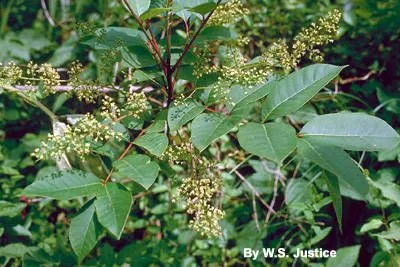
Author: (L.) Kuntze
Bibliography: Revis. Gen. Pl. 1: 153 (1891)
Year: 1891
Status: accepted
Rank: species
Genus: Toxicodendron
Vegetable: False
Observations: E. Canada to EC. & E. U.S.A.
Poison Sumac: A Detailed Exploration
Poison sumac, scientifically known as Toxicodendron vernix, is a notorious plant native to parts of Eastern Canada and the eastern and central United States. Belonging to the Anacardiaceae family, this plant was first revised and documented in 1891 by the renowned botanist (L.) Kuntze in his comprehensive work, “Revis. Gen. Pl.”
Description and Habitat
Poison sumac typically thrives in wet, swampy areas, such as bogs and marshes, where it often dominates the understory vegetation. It is a deciduous woody shrub or a small tree that can grow between 5 to 20 feet tall. The plant is characterized by its pinnately compound leaves with 7 to 13 leaflets that are arranged in pairs along a central stem, with a single terminal leaflet. These leaflets are smooth-edged, glossy, and can turn a stunning red in the fall.
Toxicity and Identification
One of the most distinguishing and infamous features of poison sumac is its sap, which contains urushiol—a potent compound that can cause severe allergic reactions in most people upon contact with the skin. The sap is found in all parts of the plant, including the leaves, stems, and berries, and remains active even after the plant is dead. Identifying poison sumac is crucial for avoiding its toxic effects; its smooth white berries, which differentiate it from the red berries of its non-toxic relatives, and its drooping clusters can help in its identification.
Ecological Role
Despite its harmful effects on humans, poison sumac plays an essential role in its ecosystem. The dense foliage provides cover and habitat for various wildlife, while the berries serve as a food source for many bird species, which in turn help in the dispersal of its seeds.
Historical and Cultural Significance
Historically, indigenous peoples and early settlers recognized the toxic properties of poison sumac. However, the plant’s wood has sometimes been used in the past for specific purposes, carefully avoiding the toxic sap. Over time, understanding and respect for this plant’s power have grown, both from a botanical perspective and in terms of public health.
Conclusion
Poison sumac (Toxicodendron vernix) is a fascinating yet hazardous plant species. Its presence in North America speaks to its adaptability and the ecological niches it fills. While its toxicity necessitates caution, poison sumac remains an integral part of the botanical landscape, revealing the complex interplay between plants and their environments.
Eng: poison sumac, poison-ash, swamp sumac
Fra: sumac à vernis, toxicodendron à vernis
En: Poison sumac, Poison-ash, Swamp sumac
Fr: Sumac à vernis, Toxicodendron à vernis
Taken Aug 6, 2015 by EOL − Johnny Wilson (cc-by-nc)
Taken Sep 26, 2020 by Guy Mueller (cc-by-sa)
Taken Jan 1, 1900 by EOL − James H. Miller & Ted Bodner, Southern Weed Science Society, Bugwood.org (cc-by)
Taken Jan 1, 1900 by EOL − James H. Miller & Ted Bodner, Southern Weed Science Society, Bugwood.org (cc-by)
Taken May 30, 2020 by Dana Bennett (cc-by-sa)
Taken Feb 17, 2016 by EOL − owenclarkin (cc-by-nc)
Taken Jul 3, 2015 by EOL − botany08 (cc-by)
Taken Jan 1, 1900 by EOL − Leonel Velasquez (cc-by-nc)
Taken Feb 19, 2016 by EOL − Andy Jones (cc-by-nc-sa)
Taken May 14, 2009 by EOL − Barry Rice (cc-by-nc-sa)
Taken Oct 19, 2014 by EOL − Evan Raskin (cc-by-nc)
Taken Sep 28, 2014 by EOL − Dan Nydick (cc-by-nc)
Taken Jan 1, 1900 by EOL − Smithsonian Institution, National Museum of Natural History, Department of Botany (cc-by-nc-sa)
Taken Aug 8, 2015 by EOL − bendingtree (cc-by-nc)
Taken Jan 1, 1900 by EOL − John Hilty (cc-by-nc)
Taken Sep 14, 2015 by EOL − Aarongunnar (cc-by-nc)
Taken Jan 31, 2016 by EOL − Aarongunnar (cc-by-nc)
Taken Sep 26, 2020 by Guy Mueller (cc-by-sa)
Taken Jan 1, 1900 by EOL − John Hilty (cc-by-nc)
© copyright of the Board of Trustees of the Royal Botanic Gardens, Kew.
Growth habit>: Tree, Shrub
Family: Myrtaceae Author: (F.Muell.) K.D.Hill & L.A.S.Johnson Bibliography: Telopea 6: 402 (1995) Year: 1995 Status:…
Family: Rubiaceae Author: Pierre ex A.Froehner Bibliography: Notizbl. Bot. Gart. Berlin-Dahlem 1: 237 (1897) Year:…
Family: Sapindaceae Author: Koidz. Bibliography: J. Coll. Sci. Imp. Univ. Tokyo 32(1): 38 (1911) Year:…
Family: Asteraceae Author: A.Gray Bibliography: Pacif. Railr. Rep.: 107 (1857) Year: 1857 Status: accepted Rank:…
Family: Fabaceae Author: Medik. Bibliography: Vorles. Churpfälz. Phys.-Ökon. Ges. 2: 398 (1787) Year: 1787 Status:…
Family: Aspleniaceae Author: (Cav.) Alston Bibliography: Bull. Misc. Inform. Kew 1932: 309 (1932) Year: 1932…